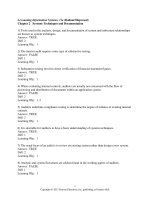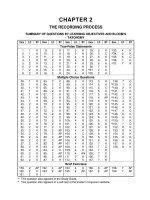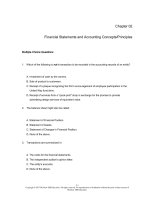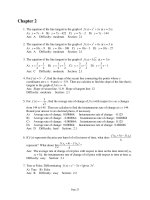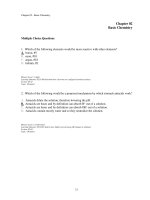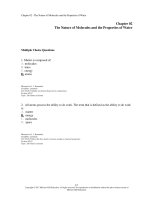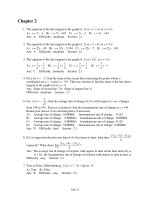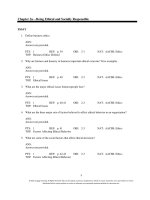Cultural anthropology 11th edition nanda test bank
Bạn đang xem bản rút gọn của tài liệu. Xem và tải ngay bản đầy đủ của tài liệu tại đây (169.9 KB, 15 trang )
Chapter 2: Doing Cultural Anthropology
MULTIPLE CHOICE
1. In place of the artificially controlled laboratory, anthropologists rely primarily on:
a. Ethnography and collaborative research.
b. Cross-cultural comparison and life histories.
c. Ethnology and mapping.
d. Ethnography and cross-cultural comparison.
e. Life histories and mapping.
ANS: D
MSC: New
DIF:
Factual
REF: 27
OBJ: 5
2. Early anthropologists who relied on travelers and missionaries for their fieldwork data were
called:
a. Armchair anthropologists.
b. Novices.
c. Native anthropologists.
d. Secondhand anthropologists.
e. Early scholars.
ANS: A
MSC: Pickup
DIF:
Factual
REF: 28
OBJ: 1
3. Lewis Henry Morgan and Edward Tylor were influenced deeply by the evolutionary
theories of:
a. Franz Boas.
b. Charles Darwin.
c. Bronislaw Malinowski.
d. Margaret Mead.
e. Carolus Linnaeus.
ANS: B
MSC: Pickup
DIF:
Factual
REF: 28
OBJ: 1
4. How would you describe Lewis Henry Morgan’s and Edward Tylor’s evolutionary theories?
a. It is the study of how humans have changed from simple to complex
communication and transportation systems.
b. It is the study of how societies have harnessed more energy for production over
time.
c. It is the study of how the human body has changed physically from earlier to later
forms, sometimes even changing species.
d. It is the study of the history of human society from simple technology and social
institutions to complex ones.
e. It is the study of how native people classify their natural world.
ANS: D
MSC: Pickup
DIF:
Applied
REF: 28
OBJ: 1
5. Lewis Henry Morgan and Edward Tylor classified small-scale societies as:
a. Savage.
b. Barbarian.
c. Primitive.
d. Childlike.
e. Civilized.
ANS: A
MSC: Pickup
DIF:
Conceptual
REF: 28
OBJ: 1
6. All of the following are associated with Franz Boas, except:
a. He was a critic of evolution.
b. He was the first professor of anthropology at Columbia University.
c. He was a champion of human rights.
d. He did his fieldwork in the Trobriand Islands.
e. He trained a generation of U.S. fieldworkers.
ANS: D
MSC: Pickup
DIF:
Factual
REF: 28-29
OBJ: 2
7. Applying one’s own cultural standards of value, worth, and morality to another culture is
called:
a. Ethnocentrism.
b. Participant observation.
c. Cultural relativism.
d. Ethnography.
e. Postmodernism.
ANS: A
MSC: New
DIF:
Factual
REF: 29
OBJ: 2
8. Boas insisted that anthropologists must value a culture on its own terms. This idea is called:
a. Logical positivism.
b. Postmodernism.
c. Phenomenology.
d. Cultural relativism.
e. Dualism.
ANS: D
MSC: New
DIF:
Factual
REF: 29
OBJ: 2
9. Which of the following has been a hallmark of American anthropology?
a. Ethnocentrism.
b. Ethnology.
c. Participant observation.
d. Multiculturalism.
e. Holism.
ANS: C
MSC: New
DIF:
Conceptual
REF: 28
OBJ: 2
10. How is Malinowski’s approach to the study of cultures different from Boas’?
a. Malinowski was an evolutionist and Boas was a critic of evolutionism.
b. Their approaches are similar, except that Franz Boas did not actually carry out
fieldwork.
c. Boas focused on the study of child-rearing, while Malinowski focused on the study
of history and body measurements.
d. Malinowski emphasized the notion of function in society, while Boas focused on
the study of history and adaptation of culture.
e. Boas focused on the study of history and adaptation, and Malinowski focused on
the study of child-rearing.
ANS: D
MSC: Pickup
DIF:
Conceptual
REF: 30
OBJ: 2
11. Malinowski’s and Boas’ practices of anthropology were alike in many ways as well. All of
the following are things that they shared except:
a. Both were committed fieldworkers.
b. Both saw other cultures/societies as fully rational.
c. Both valued the study of history as essential to a deeper understand of societies.
d. Both were scholars who opposed racism.
e. Both innovated the approach to fieldwork in anthropology.
ANS: C
MSC: Pickup
DIF:
Applied
REF: 28-30
OBJ: 2
12. The function of an Institutional Review Board (IRB) is to:
a. Certify and approve departments of anthropology.
b. Suggest disciplinary actions against researchers who violate ethical standards.
c. Approve, monitor, and review all university research involving human subjects.
d. Review articles submitted to academic journals prior to publication.
e. Fund anthropological research.
ANS: C
MSC: Pickup
DIF:
Conceptual
REF: 31
OBJ: 3
13. The fieldwork technique that involves gathering cultural data by observing people’s
behavior and participating in their lives is called:
a. Cross-cultural survey.
b. Participant observation.
c. Laboratory experimentation.
d. Structured interview.
e. Stratified random sampling.
ANS: B
MSC: Pickup
DIF:
Factual
REF: 31
OBJ: 3
14. What do anthropologists call the feelings of alienation and helplessness that result from
rapid immersion in a new and different culture?
a. Cross-cultural shock.
b. Culture shock.
c. Cultural entropy.
d. Alienation orientation.
e. Psychological solipsism.
ANS: B
MSC: New
DIF:
Factual
REF: 32
OBJ: 3
15. Individuals who serve as guides and teachers for anthropologists in the culture in which they
do fieldwork are called by all of the following terms except:
a. Consultants.
b. Managers.
c. Interlocutors.
d. Informants.
e. Respondents.
ANS: B
MSC: Pickup
DIF:
Applied
REF: 33
OBJ: 3
16. Which of the following best describes an etic perspective in research?
a. Studying agricultural techniques by measuring the fertility of the soil in laboratory
samples.
b. Studying religion by interviewing people about their belief systems.
c. Collecting recipes from informants in order to track culinary traditions.
d. Interviewing respondents about their thoughts on the political organization of their
community.
e. Following herders and writing down their life histories.
ANS: A
MSC: New
DIF:
Applied
REF: 33
OBJ: 4
17. What is the primary goal of emic research?
a. Help insiders make more effective changes to their culture over time.
b. Help governments better manage minority populations.
c. Help outsiders determine which cultures are more effective in particular
environments.
d. Help insiders gain a better understanding of their own culture.
e. Help outsiders understand what it means to be a member of another culture.
ANS: E
MSC: New
DIF:
Conceptual
REF: 33
OBJ: 4
18. Anthropological interview techniques:
a. Are always the same from field project to field project.
b. Always involve the same processes and same steps of procedure.
c. Are no longer used in contemporary fieldwork.
d. Have been adapted from philosophy.
e. Are highly varied and are situation-specific.
ANS: E
MSC: Pickup
DIF:
Conceptual
REF: 34
19. The Human Relations Area Files (HRAF) is:
OBJ: 5
a.
b.
c.
d.
e.
A database that provides cross-cultural data on a limited number of societies.
A database on all cultures involved in global warfare.
An institution that specializes in anthropological fieldwork.
A group of anthropologists that works in more than a single culture.
A database that provides cross-cultural data on all complex societies.
ANS: A
MSC: Pickup
DIF:
Factual
REF: 35
OBJ: 5
20. The Human Relations Area Files:
a. Does not allow for cross-cultural comparison.
b. Represents multiple researchers using a single perspective.
c. Involves multiple perspectives and indexed data.
d. Is no longer active today.
e. Is not available in computer searchable formats.
ANS: C
MSC: Pickup
DIF:
Conceptual
REF: 35
OBJ: 5
21. Why did anthropology pay little attention to women prior to the 1970s? All of the following
are correct except:
a. Anthropologists assumed that men’s activities were political and more important
than women’s activities, which were domestic.
b. Many anthropologists assumed that men represented women as well and there was
no need to study these as separate genders.
c. The majority of practicing anthropologists was male and had little access to
working with women in other societies.
d. Anthropologists were all male and there were no women available to study other
women.
e. Men’s roles were much more public and were more easily studied.
ANS: D
MSC: Pickup
DIF:
Conceptual
REF: 37
OBJ: 6
22. Which sentence best describes the primary anthropological value of research among the
homeless and drug addicts, such as that produced by Philippe Bourgois?
a. This research provides accurate information that can help the lives of these
individuals by providing more effective recovery programs.
b. The commercial success of research such as this raises awareness of the plight of
these individuals and can provide a great deal of money to improve their
communities.
c. This research allows families to identify and reconnect with their loved ones and
intervene to help them.
d. Through research such as this, the United States is able to provide much more
foreign aid to countries that provide the drugs to these addicts.
e. By providing accurate information, research such as this allows us to chronicle the
problems with state societies and new models for the future.
ANS: A
MSC: New
DIF:
Applied
REF: 36-37
OBJ: 7
23. What is the “gray zone” that Philippe Bourgois describes in his work among the homeless
and drug addicts in San Francisco?
a. It is a geographical area in which drug exchanges take place.
b. It is a term used to refer to homeless shelters and parks where these individuals
interact.
c. It is a morally ambiguous space that blurs the lines between victims and
perpetrators.
d. It is a term used to describe under-employment because it leads to the destruction
of their lives.
e. It is a judicial term to describe exchanges that are morally wrong, but not illegal.
ANS: C
MSC: New
DIF:
Conceptual
REF: 36
OBJ: 7
24. Which theoretical approach argues that no knowledge is objective and all knowledge is
influenced by the observer’s own culture, social position, and gender?
a. Native anthropology.
b. Feminist anthropology.
c. Postmodernism.
d. Transcendental ethnography.
e. Collaborative ethnography.
ANS: C
MSC: Pickup
DIF:
Applied
REF: 38
OBJ: 6
25. Anthropologists have become more sensitive to issues of voice and of power and have
begun to reflect more critically on their role as observer in another culture primarily as a
result of:
a. Reflectionist ethnology.
b. Franz Boas.
c. Feminist anthropology.
d. Collaborative ethnography.
e. Postmodernism.
ANS: E
MSC: Pickup
DIF:
Conceptual
REF: 38
OBJ: 6
26. You Owe Yourself a Drunk (1970) by James Spradley is an example of a(n) __________
ethnography.
a. Critical
b. Postmodernist
c. Collaborative and engaged
d. Ethnological
e. Reflectionist
ANS: C
MSC: Pickup
DIF:
Applied
REF: 38
OBJ: 7
27. Vincent Lyon-Callo works with homeless people. His style of anthropology is best
described as:
a. Symbolic and interpretive.
b.
c.
d.
e.
Functionalism.
Psychological.
Engaged.
Ecological.
ANS: D
MSC: Pickup
DIF:
Applied
REF: 39
OBJ: 7
28. Vincent Lyon-Callo’s work with homeless people stresses:
a. The structural causes of homelessness.
b. Incorrect beliefs about the homeless among members of the middle class.
c. The stories and life histories of homeless people.
d. The techniques the homeless use to survive in urban areas.
e. Drug and alcohol use among homeless.
ANS: A
MSC: Pickup
DIF:
Conceptual
REF: 40
OBJ: 7
29. Which of the following was primarily known as a native anthropologist?
a. Zora Neale Hurston
b. Franz Boas
c. Bronislaw Malinowski
d. Vincent Lyon-Callo
e. James Spradley
ANS: A
MSC: Pickup
DIF:
Factual
REF: 42
OBJ: 7
30. Delmos Jones’ study of voluntary organizations among an African-American community in
the United States showed him that:
a. No one worked consistently for the organizations unless they were paid for their
work.
b. Voluntary organizations are highly successful when founded by minority leaders.
c. His work as a native anthropologist was at the center of the success the
African-American community experienced in cultural identity.
d. There was considerable dissent between leadership of the organizations and the
members.
e. Native anthropology has little or no value in the discipline.
ANS: D
MSC: Pickup
DIF:
Conceptual
REF: 43
OBJ: 7
31. A major point of the ethnography "Body Ritual among the Nacirema" is to:
a. Show how foolish people's rituals are.
b. Help us look at our own culture from a different perspective.
c. Promote practices of preventive medicine.
d. Increase our respect for primitive cultures.
e. Put a little laughter into our dreary lives.
ANS: B
MSC: Pickup
DIF:
Conceptual
REF: 40-41
OBJ: 5
32. The attitude toward magic and ritual among the Nacirema indicates that:
a. Technologically advanced societies do not use magic and ritual.
b. Too much magic and ritual will destroy a society.
c. Magic and ritual can be found in a wide variety of cultures.
d. North American society contains very little magic and ritual.
e. Only the weakest individuals in a society are likely to make use of magic and
ritual.
ANS: C
MSC: Pickup
DIF:
Conceptual
REF: 40-41
OBJ: 5
33. What is the name of the organization that maintains a statement of ethical guidelines for
anthropologists?
a. Association for American Anthropologists.
b. American Anthropological Institute.
c. American Anthropological Association.
d. Anthropological Ethics Institute.
e. American Association of Anthropologists.
ANS: C
MSC: Pickup
DIF:
Factual
REF: 43
OBJ: 8
34. Informed consent involves all of the following except:
a. Anthropologists must be involved in a dynamic discussion with participants in
order to explain the significance of informed consent.
b. Individuals should understand the risks and benefits inherent in the research.
c. Participants must sign a witnessed contract with the anthropologist indicating that
they approve of the research study.
d. Participants must understand how the research data is likely to affect them.
e. Individuals must be free to decide if they want to participate.
ANS: C
MSC: Pickup
DIF:
Applied
REF: 43
OBJ: 8
35. For the academic community, a critical problem with secret research is:
a. It may endanger the lives of the anthropologists who pursue it.
b. The scientific community has no way to assess its validity.
c. It is almost always used for illegal or immoral purposes.
d. It is unlikely to provide benefits to either anthropologists or the people who are the
subjects of such research.
e. It can rarely be used to support the tenure and promotion of anthropology
professors.
ANS: B
MSC: Pickup
DIF:
Conceptual
REF: 44-45
OBJ: 8
36. All of the following are ethical concerns raised by anthropologists who work in military
projects such as Human Terrain Systems (HTS) except:
a. Inability to obtain informed consent.
b. Inability to keep the confidentiality of informants.
c. Secretive nature of so much of the research data.
d. Safety of informants.
e. Inability to pay the informants adequately.
ANS: E
MSC: New
DIF:
Conceptual
REF: 45
OBJ: 8
37. In anthropology, the issue of human rights:
a. Is not relevant, because anthropologists believe in cultural relativism.
b. Can be difficult, as different cultures define rights differently.
c. Is at the forefront of doing anthropological research, as researchers are not allowed
to work in countries where there is warfare.
d. Is not important, because there are no inalienable human rights.
e. Prevents anthropologists from doing research overseas.
ANS: B
MSC: Pickup
DIF:
Conceptual
REF: 46-47
OBJ: 8
38. Anthropologists and activists have argued that female genital operations are all of the
following except:
a. Are grave violations of human rights.
b. Are affirmations of the value of women.
c. Should be legal in European nations.
d. Should be banned in European nations.
e. Should not be studied because they are not important.
ANS: E
MSC: Pickup
DIF:
Applied
REF: 47
OBJ: 8
TRUE/FALSE
1. The gathering and interpretation of information based on intensive, firsthand study is called
ethnography.
ANS: T
REF: 27
MSC: Pickup
2. Franz Boas spent most of his professional career at the University of Berlin in Germany.
ANS: F
REF: 28
MSC: Pickup
3. Today, virtually all anthropologists rely on Boas’ basic and fundamental insights into the
discipline.
ANS: T
REF: 29
MSC: New
4. In the late 19th century, Haddon led a team of scientists to do research on the Torres Straits.
This lay the basis for anthropology in the United States.
ANS: F
REF: 29
MSC: Pickup
5. Bronislaw Malinowski spent only 6 months on the Trobriand Islands.
ANS: F
REF: 30
MSC: Pickup
6. Anthropologists rarely work with groups of more than 50 individuals.
ANS: T
REF: 31
MSC: Pickup
7. It is common for anthropologists to feel confused and disoriented when they first arrive to
their field sites.
ANS: T
REF: 32
MSC: Pickup
8. Allison Truitt’s work on motorcycles in Vietnam had no formal research hypothesis.
ANS: T
REF: 33
MSC: Pickup
9. Most anthropological data comes in the form of extensive field notes, audio recordings, and
photographs.
ANS: T
REF: 34
MSC: Pickup
10. Cross-cultural comparisons began formally in social science with the publication of Herbert
Spencer’s Descriptive Sociology.
ANS: T
REF: 35
MSC: Pickup
11. The HRAF is an attempt to facilitate cross cultural analysis.
ANS: T
REF: 35
MSC: Pickup
12. Once Franz Boas began teaching women and producing female PhDs, the bias against
women in anthropology began to diminish rapidly.
ANS: F
REF: 37
MSC: New
13. Phillip Bourgois’ work with the homeless and drug addicts in San Francisco has led to a
better understanding of issues of economic change, cultural structures, and the effects on
individual lives.
ANS: T
REF: 36-37
MSC: New
14. Postmodernism has been accepted now by all anthropologists.
ANS: F
REF: 38
MSC: Pickup
15. Engaged anthropologists refrain from choosing sides in political contests.
ANS: F
REF: 39
MSC: Pickup
16. The most important ethical responsibility in anthropological fieldwork is to protect the
interests of the people whom you are studying.
ANS: T
REF: 43
MSC: Pickup
17. Project Camelot was a great example of collaborative success between anthropology and the
U.S. military.
ANS: F
REF: 44
MSC: New
18. Anthropologists working for government and industry often conduct secret research and this
poses no ethical challenges to the discipline.
ANS: F
REF: 44-45
MSC: Pickup
19. The Human Terrain Systems was a successful project that allowed anthropologists to work
alongside soldiers during war so that cultural sensitivity in the ranks could be maintained.
ANS: F
REF: 44-45
MSC: New
20. Anthropologists generally agree that they should defend Western notions of human rights.
ANS: F
REF: 47
MSC: Pickup
SHORT ANSWER
1. What do anthropologists use as the basis for cross-cultural comparisons?
ANS:
They use ethnographies.
REF: 27
MSC: New
2. What did early 19th century evolutionists mean by the concept of societies as “living
fossils”?
ANS:
They were examples of what more advanced societies were believed to have looked like in
their earlier states of evolution.
REF: 28
MSC: New
3. Boas’ style of fieldwork was known as __________ __________.
ANS:
Participant observation.
REF: 28
MSC: New
4. What is participant observation?
ANS:
It is an approach to fieldwork in which anthropologists live among the people they study,
observing their culture and where possible participating in it.
REF: 28-29
MSC: Pickup
5. The research of Bronislaw Malinowski focuses on the concept of __________.
ANS:
function.
REF: 30
MSC: New
6. What is an “IRB”?
ANS:
It is the Institutional Review Board, which is a committee organized by a university or other
research institution to approve, monitor, and review all research involving human subjects.
REF: 31
MSC: New
7. How would you best describe culture shock?
ANS:
It is feelings of alienation and helplessness that result from rapid immersion in a new and
different culture.
REF: 32
MSC: New
8. Compare and contrast the emic and etic perspectives. What are the strengths and weaknesses
of each?
ANS:
Emic is the insider point of view. It expresses things meaningful within that culture. This
may not always be something easily understood by outsiders. The etic perspective is the
scientific approach to another society. This is easily translatable across cultures, but it may
seem less meaningful and emotive as a form of understanding.
REF: 33
MSC: New
9. What are two criticisms associated with the Human Relations Area Files database?
ANS:
It takes cultural data out of context and it collates multiple perspectives from different time
periods and does not take into account how the different authors and historical eras affect
the data.
REF: 35
MSC: New
10. What is the “gray zone” that Philippe Bourgopis describes as part of his work with the
homeless and drug addicts in San Francisco?
ANS:
It is a morally ambiguous space that blurs the lines between victims and perpetrators.
REF: 36-37
MSC: New
11. What are the primary reasons that anthropological research has had such a bias against
women during its history?
ANS:
Women’s lives have been less public than men’s; men’s lives have usually had more
political importance and been seen as more important overall; and most anthropologists
have been men and thus had little access to women’s lives.
REF: 37
MSC: New
12. What changes did postmodernism bring to anthropological fieldwork?
ANS:
It encouraged anthropologists to look at their own personal roles in the field and how they
interacted with their informants.
REF: 38
MSC: New
13. Name at least 3 challenges associated with collaborative ethnography.
ANS:
Answers can include: to represent accurately and not just what informants want, to report to
the best of the anthropologist’s ability, to not knowingly falsify information, to understand
that no community is homogeneous and all voices cannot be represented equally, and to be
aware that collaborative work can lead to biased reporting and personal pressures.
REF: 38-39
MSC: Pickup
14. Who are the Nacirema, and why is this study important in anthropology?
ANS:
It is the Americans and it allows us to see ourselves as very much like other people and
other societies.
REF: 40-41
MSC: New
15. What is a “native” anthropologist?
ANS:
It is an anthropologist who does fieldwork in his or her own culture.
REF: 42
MSC: New
16. What are the ethical responsibilities for anthropologists in the field?
ANS:
There are responsibilities to the people studied which includes ensuring their dignity and
privacy, respecting anonymity, not exploiting them, and providing fair return for their
services and work. It also includes the responsibility to communicate the findings publicly
and also protect the interests of science and other anthropologists.
REF: 43
MSC: New
17. Why is informed consent an important part of doing ethical research?
ANS:
It ensures the people studied understand what you are doing and have an opportunity to ask
questions or withdraw from the study.
REF: 43
MSC: New
18. What was “Project Camelot”?
ANS:
It was a project headed by the U.S. Army and Department of Defense to enlist
anthropologists and other social scientists in achieving American foreign policy goals.
REF: 44
MSC: New
19. Today, how have ethnographers’ roles changed in the field?
ANS:
Today, ethnographers are working more with informed and involved informants. As a result,
their works are being read by members of their own field communities and the need for
ethical relations is critically important. In addition, however, natives’ increased knowledge
of the outside has led as well to closer relations between anthropologists and their
informants.
REF: 46
MSC: New
20. What is FGO, and why is it important in anthropology?
ANS:
It stands for Female Genital Operation and anthropology struggles with various positions
regarding this cultural practice—ranging from a cultural choice to a violation of human
rights.
REF: 47
MSC: New
ESSAY
1. Culture shock is a phenomenon that can occur to anyone who faces a new environment
where the rules and behaviors are different from what they know. What is the role of culture
shock in anthropological fieldwork? When does it occur, and why does it happen? Give
examples in your own life when you have faced culture shock.
ANS:
Answer not provided.
2. What is cross-cultural comparison, and why is this important in our study of humans and
culture? What can we learn through cross-cultural comparisons?
ANS:
Answer not provided.
3. Anthropology has faced various challenges in its history from the study of women to that of
more marginal populations, such as those of the homeless and drug addicts. Choose one of
these challenges and discuss it in detail, noting what the challenges have been, why the
challenges occurred, and how they have been handled differently in anthropological
research today.
ANS:
Answer not provided.
4. Define participant observation and discuss why it is important in the anthropological
mission.
ANS:
Answer not provided.
5. Why are ethical considerations so important to the practice of anthropology? Use examples
from the book and discuss each of the ethical responsibilities required of anthropologists.
What kinds of ethical dilemmas would you imagine are quite common during fieldwork?
ANS:
Answer not provided.
